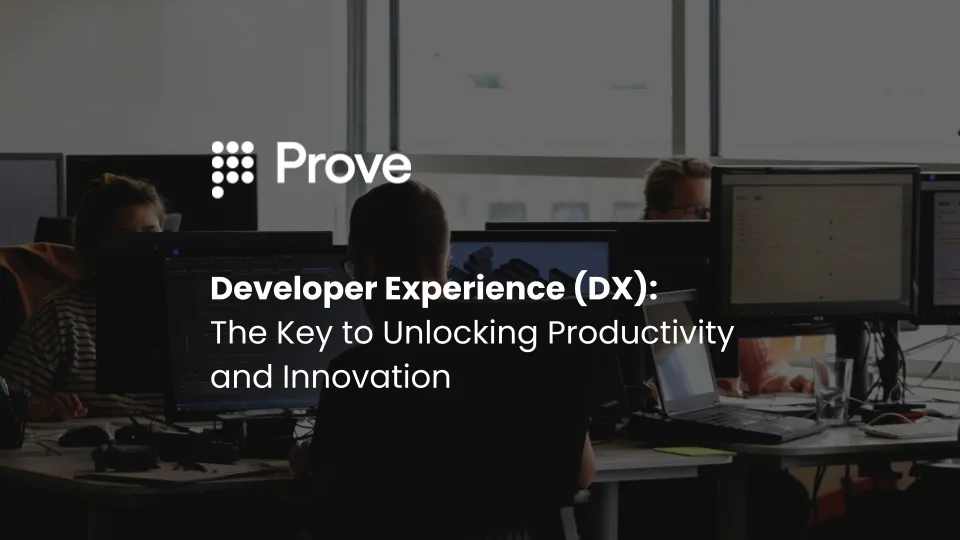Developer Experience (DX): The Key to Unlocking Productivity and Innovation


In today's fast-paced software development landscape, where the demand for high-quality software is ever-increasing, organizations are constantly seeking ways to accelerate the development process and improve the efficiency of their development teams. Amidst this pursuit, the concept of Developer Experience (DX) has emerged as a critical factor in determining the success of software development initiatives. DX encompasses the overall experience that developers have while interacting with the tools, processes, and environments they use to build and deliver software. By prioritizing DX, organizations can create an environment that fosters productivity, innovation, and ultimately, the creation of exceptional software products.

Understanding the Importance of DX
DX plays a pivotal role in several key areas:
- Productivity: When developers have a positive experience with the tools and processes they use, they are more likely to be engaged, motivated, and productive. A well-designed DX eliminates unnecessary friction and streamlines workflows, allowing developers to focus on what they do best - writing code and solving problems. By removing obstacles and providing the right tools and resources, organizations can empower developers to work efficiently and deliver high-quality software faster.
- Attracting and Retaining Talent: In today's competitive talent market, organizations need to offer more than just a paycheck to attract and retain top developers. DX is a crucial factor in creating an appealing work environment for developers. By providing modern tools, clear documentation, and supportive processes, organizations can demonstrate their commitment to developer well-being and create a culture that fosters growth and development. A positive DX can be a powerful differentiator in attracting and retaining the best talent in the industry.
- Innovation: Innovation is at the heart of software development. By providing developers with the freedom to experiment, explore new technologies, and collaborate effectively, organizations can cultivate an environment that encourages innovation. DX plays a crucial role in enabling developers to push boundaries, try new approaches, and ultimately, create groundbreaking software solutions.
- Collaboration and Knowledge Sharing: Effective collaboration and knowledge sharing are essential for successful software development. DX can facilitate these activities by providing tools and platforms that enable seamless communication, code sharing, and collaborative problem-solving. When developers can easily share their knowledge and expertise, the entire team benefits, leading to improved code quality, faster development cycles, and a more cohesive and supportive work environment.

Key Elements of an Effective DX
To create a positive DX, organizations need to focus on several key elements:
- Tools and Technologies: The tools and technologies that developers use have a significant impact on their overall experience. Organizations should invest in modern, efficient tools that are well-suited to the specific needs of their development teams. This includes integrated development environments (IDEs), version control systems, code review tools, continuous integration and continuous delivery (CI/CD) pipelines, and other tools that streamline workflows and enhance productivity.
- Documentation and Onboarding: Clear and comprehensive documentation is essential for a smooth onboarding process and ongoing developer support. Organizations should provide well-structured documentation that covers everything from setting up development environments to troubleshooting common issues. By investing in quality documentation, organizations can empower developers to become self-sufficient and reduce the time spent on resolving basic questions and problems.
- Community and Support: A strong community and readily available support can greatly enhance the developer experience. Organizations should foster a culture of collaboration and knowledge sharing, where developers can connect with each other, exchange ideas, and seek help when needed. This can be achieved through internal forums, chat channels, mentorship programs, and other initiatives that encourage interaction and support.
- Feedback and Iteration: Continuous feedback and iteration are crucial for improving DX. Organizations should actively seek feedback from developers about their experiences, challenges, and suggestions for improvement. This feedback can be gathered through surveys, interviews, and other channels. By incorporating developer feedback into the DX strategy, organizations can ensure that their efforts are aligned with the needs and preferences of their development teams.
Strategies for Enhancing DX
There are several strategies that organizations can employ to enhance DX:
- Automate Repetitive Tasks: Automation can significantly improve DX by eliminating tedious and time-consuming tasks. Organizations should identify opportunities to automate repetitive tasks such as code formatting, testing, and deployment. By freeing developers from these mundane activities, they can focus on more creative and strategic work.
- Simplify Development Environments: Complex and cumbersome development environments can hinder productivity and create frustration. Organizations should strive to simplify development environments by providing clear instructions, pre-configured setups, and tools that facilitate easy environment management.
- Embrace DevOps Practices: DevOps practices, which emphasize collaboration between development, operations, and other teams, can greatly improve DX. By fostering a culture of shared responsibility and continuous improvement, organizations can streamline workflows, reduce friction, and accelerate software delivery.
- Prioritize Developer Well-being: A healthy and happy developer is a productive developer. Organizations should prioritize developer well-being by creating a supportive and inclusive work environment, offering flexible work arrangements, and providing opportunities for professional development.
Measuring and Improving DX
Measuring and improving DX is an ongoing process. Organizations should regularly collect data on developer satisfaction, productivity, and other relevant metrics. This data can be used to identify areas for improvement and track the impact of DX initiatives. By continuously monitoring and refining their DX strategy, organizations can ensure that they are providing the best possible experience for their developers.
Introducing Prove Pre-Fill
Prove offers a suite of features that significantly enhance the developer experience.
Simplified Authentication
Prove Pre-Fill streamlines authentication and authorization processes, eliminating the complexities often associated with managing user identities and access permissions. This allows developers to focus more on building core features rather than wrestling with intricate authentication flows. Our Client SDK (available for Web, Android, and iOS) first retrieves an authToken as a parameter for the Authenticate() function. This token is returned from the Start() call of the Server SDK. See below for an example of our iOS SDK using Swift.
// The below example uses native iOS URLSession, but any other
// alternative networking approaches should also work
func initialize(phoneNumber: String, ssn: String, flowType: String, completion: @escaping (Result\<String, Error>) -> Void) {
guard let url = URL(string: "\(backendUrl)/initialize") else {
completion(.failure(URLError(.badURL)))
return
}
var request = URLRequest(url: url)
request.httpMethod = "POST"
request.addValue("application/json", forHTTPHeaderField: "Accept")
request.addValue("application/json", forHTTPHeaderField: "Content-Type")
// Set up the request body
let body: [String: Any] = [
"phoneNumber": phoneNumber,
"flowType": flowType,
"ssn": ssn
]
do {
request.httpBody = try JSONSerialization.data(withJSONObject: body, options: \[])
} catch {
completion(.failure(error))
return
}
// Perform the request
let task = URLSession.shared.dataTask(with: request) { \_, response, error in
// Handle network or connection errors
if let error = error {
completion(.failure(error))
return
}
do {
if let json = try JSONSerialization.jsonObject(with: data, options: \[]) as? [String: Any],
let authToken = json["authToken"] as? String {
completion(.success(authToken))
} else {
let parsingError = NSError(domain: "", code: 0, userInfo: [NSLocalizedDescriptionKey : "Failed to parse JSON or authToken is missing"])
completion(.failure(parsingError))
}
} catch {
completion(.failure(error))
}
}
// Start the network call
task.resume()
}
Next we build the authenticator for the mobile flow.
// Object implementing ProveAuthFinishStep protocols
let finishStep = FinishAuthStep()
// Objects implementing OtpStartStep/OtpFinishStep protocols
let otpStartStep = MobileOtpStartStep()
let otpFinishStep = MobileOtpFinishStep()
let proveAuthSdk: ProveAuth
proveAuthSdk = ProveAuth.builder(authFinish: finishStep)
.withOtpFallback(otpStart: otpStartStep, otpFinish: otpFinishStep)
.build()
Finally we perform the authentication.
// authToken retrieved from your server via StartAuthRequest
proveAuthSdk.authenticate(authToken) { error in
DispatchQueue.main.async {
self.messages.finalResultMessage = "ProveAuth.authenticate returned error: \(error.localizedDescription)"
print(self.messages.finalResultMessage)
}
}
Reduced Integration Effort
With its comprehensive suite of pre-built components and APIs, Prove Pre-Fill minimizes the integration effort required. Developers can seamlessly incorporate advanced authentication functionalities into their applications without having to build everything from scratch. We provide Server SDKs in the following languages: Java, TypeScript/JavaScript, and Go. If your backend language is not currently supported, you can easily interact with our REST APIs. We provide client SDKs in the following languages: JavaScript/TypeScript, Java (Android), and Swift (iOS). We only support the the Prove flow through our client SDK using logic and security built into the SDK that removes a lot of the complex implementation work that you would need to do in order to support. The benefit is as we release new features, it's easy to upgrade and gain access to the new capabilities.
Improved User Experience
By simplifying your customer experience (CX), Prove Pre-Fill contributes to a smoother and more enjoyable user experience. This can lead to increased user engagement and satisfaction with the application.
Time Savings
By streamlining backend and frontend development, Prove Pre-Fill frees up valuable developer time. This allows them to concentrate on core development tasks and accelerate the delivery of new features and functionalities.
Conclusion
In conclusion, Developer Experience (DX) is a critical factor in the success of software development initiatives. By prioritizing DX, organizations can create an environment that fosters productivity, innovation, and ultimately, the creation of exceptional software products. By investing in modern tools, clear documentation, supportive communities, and continuous feedback, organizations can empower developers to work efficiently, collaborate effectively, and deliver high-quality software faster. DX is not just a buzzword; it's a strategic imperative for organizations that want to thrive in today's competitive software development landscape. The focus is simplification, integration, security, and user experience results in a significant improvement in the developer experience. It enables developers to build more secure and user-friendly applications with greater efficiency.

Keep reading
 Read the article: Prove Launches Global Identity Graph to Redefine Digital Trust for 90% of Digital Consumers
Read the article: Prove Launches Global Identity Graph to Redefine Digital Trust for 90% of Digital ConsumersProve has launched its Global Identity Graph, a foundational platform that connects verified human identities to their digital tokens, redefining digital trust and enabling instant, frictionless, and secure engagement for over 90% of digital consumers worldwide.
 Read the article: Prove Partners with Hard Rock Bet to Deliver Elite Onboarding and Enhance Player Experience
Read the article: Prove Partners with Hard Rock Bet to Deliver Elite Onboarding and Enhance Player ExperienceProve and Hard Rock Bet partner to deliver elite player onboarding by using Prove Pre-Fill® to instantly verify identities, streamline signup, and enhance security in online gaming.
 Read the article: Prove and Backbase Partner to Enable Faster and Safer Onboarding for Financial Institutions
Read the article: Prove and Backbase Partner to Enable Faster and Safer Onboarding for Financial InstitutionsThe Prove Pre-Fill solution integrates with Backbase’s AI-powered Banking Platform to reduce fraud, streamline data entry, and improve digital account opening experiences.












